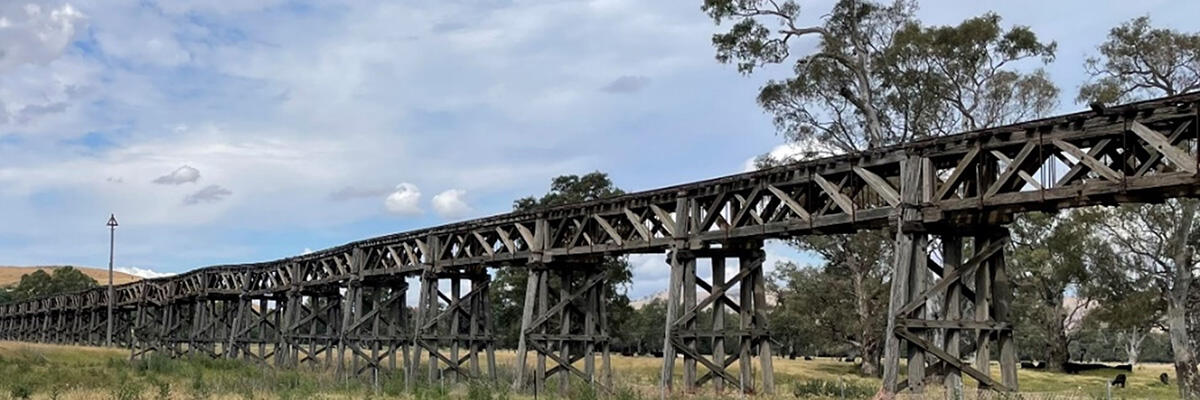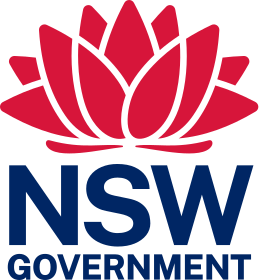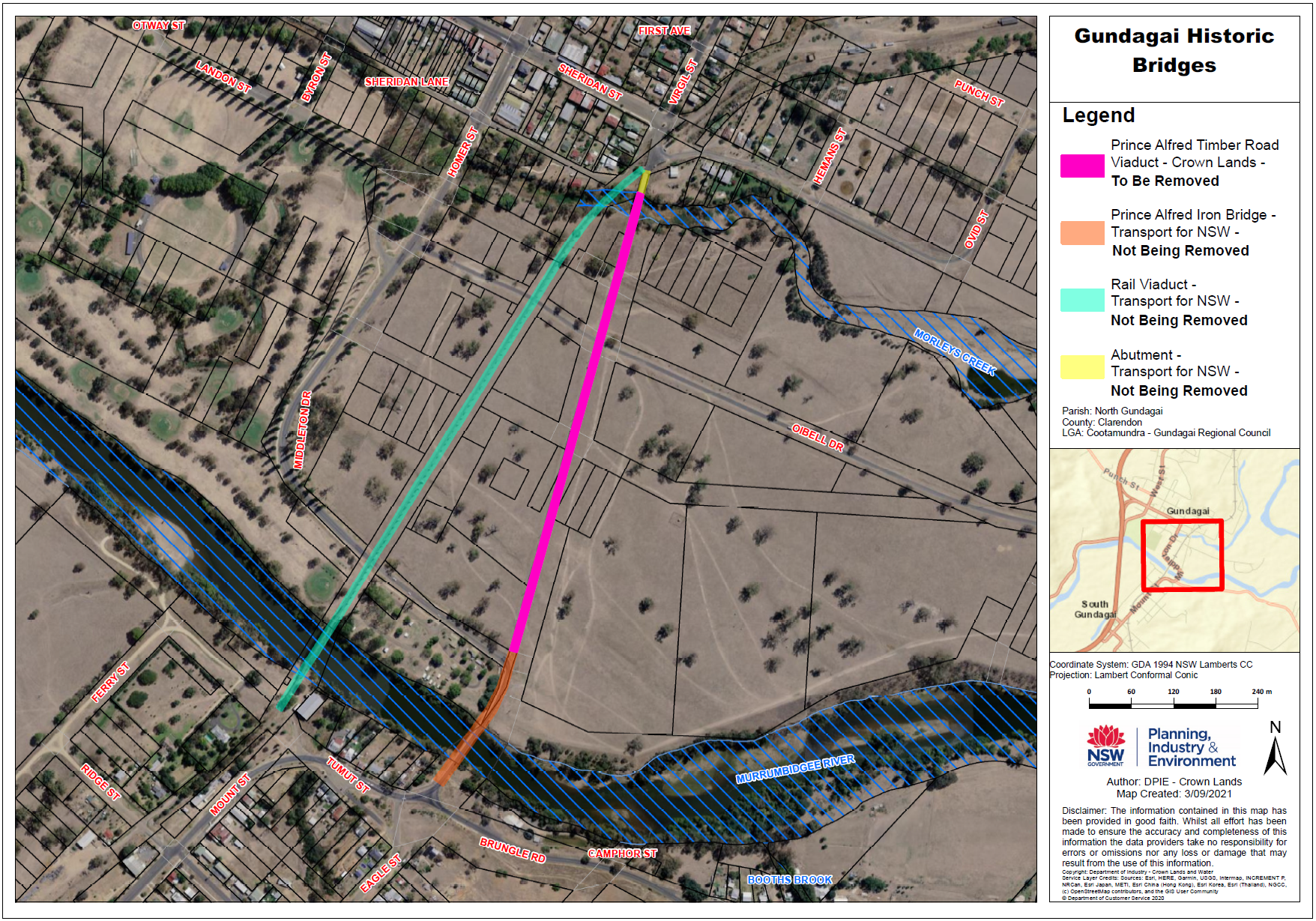Gundagai historic bridges
Project overview
Transport for NSW is monitoring Gundagai’s historic bridges.

Built in 1903, the Gundagai Rail Viaduct is a Howe timber truss bridge which sits next to the site of the former road bridge and is an impressive 819.4 metres long. This bridge serviced the Tumut area for 82 years and is listed on the state heritage register. The non-operational bridge holds cultural and historical significance for the community and key stakeholders.
For more information on the Gundagai Rail Viaduct, please visit the project page.
Project information
Update on Rail Viaduct
Transport is working to implement measures to ensure the ongoing safety of the Rail Viaduct in the short to medium term. We are also working to develop a long-term strategy for the Viaduct as part of Transport's Regional Rail Heritage Strategy.
The maintenance of this viaduct is managed by UGL Regional Linx (UGLRL) on behalf of Transport. Transport continues to work with UGLRL to ensure public safety at Gundagai Viaduct.
Between November 2022 and July 2023, the following safety measures were installedto address the immediate risk of falling debris such as loose bolts or timber sleepers:
- a covered pedestrian walkway over the pedestrian path adjacent to Middleton Drive
- monitoring cameras at Middleton Drive and OI Bell Drive at the intersection of the Viaduct
- concrete bollards at Middleton Drive and OI Bell Drive at the intersection of the Viaduct
- the closure of the track under span 25 adjacent to OI Bell Drive (previously used by high-sided vehicles accessing the showground)
- repair of flood-damaged fencing between OI Bell Drive and Middleton Drive
- additional fencing at Morleys Creek and adjacent to the golf course
- free-standing portal netting structure over Middleton Drive and OI Bell Drive.
UGLRL carries out regular inspections of the Rail Viaduct to ensure public safety.
Next steps
Transport and UGLRL are currently investigating the potential to install steel supports at both Middleton Drive and OI Bell Drive to further improve public safety.
We are seeking advice from engineering experts to confirm the nature and extent of the steel supports required.
Transport will update you when the scope of work for the steel supports is confirmed. We will also update the community and stakeholders before work starts to install the supports.
Regional Rail Heritage Strategy
The long-term future of the Gundagai Viaduct will be informed by Transport's Regional Rail Heritage Strategy (Strategy), which is currently under development.
The purpose of the Strategy is to identify priorities for conservation across the timber underbridge asset class and provide recommendations for the ongoing management of regional rail heritage assets.
A draft strategy will be available for public consultation, pending endorsement by the Heritage Council of NSW.
We will keep you informed as our work progresses and provide more information on the public consultation process for the Strategy.
For more information about this project, please email CRNnon-operationalbridges@transport.nsw.gov.au.
Prince Alfred Bridge – road viaduct
Built in 1896, the Prince Alfred Bridge (timber road viaduct) in Gundagai NSW, had not been operational since 1984. It was the first major bridge crossing over the Murrumbidgee River.
Having deteriorated extensively and in very poor condition, it was identified as a risk to public safety and property, and risk of structural collapse during a flood event. The southern end of the bridge remains in service today (and will not be removed), while about 711 metres of approach that spans to the north have now been removed.
The NSW Government dismantled the timber road viaduct in November 2021. Considerations that led to this decision included public safety risk, cost of repair and maintenance, environmental cost of replacing the timbers and risk of flood.
As part of the bridge’s removal, the NSW Government completed a Review of Environmental Factors (REF), to ensure the natural environmental attributes, including local waterways and animal populations, were not adversely impacted.
More than 460 cubic metres of timber and trestles were salvaged during the removal of Prince Alfred Bridge. Additionally, one whole timber trestle and 12 half trestles were salvaged.
A further eight timber trestles will remain in the ground, which have been cut to 1.5 metres, located south of O.I. Bell Drive and north of O.I. Bell Drive, to commemorate the former position of the bridge.
Road viaduct memorialised
Crown Lands is leading memorialisation of the removed sections of road viaduct.
For more information, see the website.
Benefits
The Gundagai historic bridges project will:
- improve safety
- reduce environmental impacts.
Community information
Frequently asked questions (FAQs)
- Why was a section of Prince Alfred Bridge removed?
Prince Alfred Bridge (timber road viaduct) is a timber road viaduct which has not operated since 1984 and is no longer used for transport.
The timber road viaduct deteriorated extensively and was in very poor condition, creating a significant public safety risk.
The NSW Government also monitored the Murrumbidgee River water levels, rain predictions and dam water releases as engineering advice shows a major 1-in-5-year flood (over 7.1 metres on the Gundagai River Gauge) could further damage the bridge and potentially cause downstream damage to other infrastructure. - Why couldn’t the timber road viaduct be replaced or fixed?
It was not economically or environmentally feasible to restore the timber road viaduct given the high cost, the requirement for large unsustainable amounts of timber, maintenance requirements, and a lack of Transport need for the disused bridge.
Instead, the NSW Government engaged with the community on what they believe to be potential memorial options for the timber road viaduct. - Were any experts consulted before this decision was made?
The NSW Government engaged an independent engineering consultant to prepare a comprehensive report on the timber road viaduct’s condition, which showed significant structural defects and safety issues.
Based on this advice, the NSW Government concluded that the timber road viaduct must be removed as soon as possible to protect public safety.
Ongoing consultations on the timber road viaduct occurred through a working group including representatives from Transport for NSW, Crown Lands, Cootamundra-Gundagai Regional Council, Gundagai Historic Bridges Inc, the National Trust, Engineers Australia, and Heritage NSW (Department of Premier and Cabinet). - What actions are you taking to protect the environment and animal welfare?
The NSW Government carried out a Review of Environmental Factors (REF), which examined and took into account all matters affecting or likely to affect the environment by the proposed removal of the timber road viaduct.
As a part of the REF, a Bat Management Plan was developed as bats were known to roost and breed in the timber road viaduct throughout different seasons. A heritage impact statement, notification and consultation with the community was also be carried out as part of the development of the REF. - Is the timber road viaduct listed on the State Heritage Register?
The timber road viaduct was not listed on the State Heritage Register but was considered to be of local heritage significance.
The operational section of Prince Alfred Bridge over the Murrumbidgee River, as well as the disused rail viaduct, are both State Heritage-listed and are being retained.
Heritage interpretation options for the timber road viaduct will be developed in consultation with the community, Cootamundra-Gundagai Regional Council and other key stakeholders. - Will the timber road viaduct be replaced?
The NSW Government sought feedback in late 2021 on how we can memorialise the bridge. The survey was open between 24 September and 31 October, 2021, and received a total of 139 submissions. - Who is managing the project?
Crown Lands and Transport for NSW are working collaboratively on this project, as the relevant landowners.
Community residents with questions or requests are advised to contact Crown Lands for further information on the project.
- Email:wagga.crownlands@crownland.nsw.gov.au
- Mail: DPIE Crown Lands, PO Box 2185, Dangar NSW 2309
- Website: dpie.nsw.gov.au/gundagai-historic-bridges
- What does the project team plan to do with the timber and other materials removed from the bridge?
More than 460 cubic metres of timber and trestles were salvaged from the removal of Prince Alfred Bridge’s timber road viaduct, to support construction of a heritage memorial option. This includes one whole timber trestle and 12 half trestles from the timber road viaduct, which have been salvaged for use in future interpretation. These have been transported to the Cootamundra-Gundagai Regional Council’s depot for storage until a future use is determined.
Contact us
Rail Viaduct
For more information about the Rail Viaduct, please email CRNnon-operationalbridges@transport.nsw.gov.au.
For more information about the removed section of the Road Viaduct, please contact:
Email: wagga.crownlands@crownland.nsw.gov.au
Mail: DPIE Crown Lands, PO Box 2185, Dangar NSW 2309
Website: dpie.nsw.gov.au/gundagai-historic-bridges
For more information about the operational section of Prince Alfred Bridge, please contact:
Email: southprojects@transport.nsw.gov.au
Mail: Transport for NSW, PO Box 484, Wagga Wagga NSW 2650

